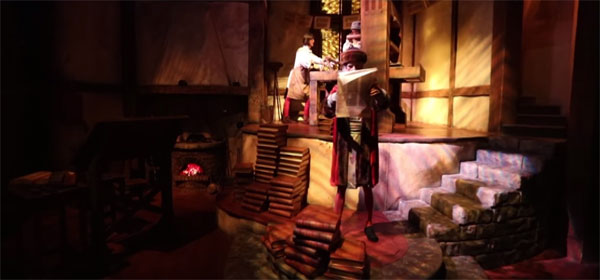
We have reached the turning point in the journey through our Spaceship Earth. Up to this point, it’s been a fairly slow trip with easily separated scenes. Now the pace increases thanks to a pivotal invention from Johann Gutenberg — the movable type printing press! This revolution helped spawn The Renaissance and so many key discoveries. Passing a series of quick vignettes, we glide past major developments with a new sense of whimsy for our journey. Walter Cronkite’s words help to introduce this changing landscape:
“The dawn of the Renaissance brings a wondrous new machine, the printing press. Now books and authors flourish as never before.”
Each narrator offers a simple intro for The Renaissance, and it’s not surprising to see fewer dramatic changes between each version in this section. Jeremy Irons clearly delineates the “depths of the Dark Ages” from this new Age of Enlightenment. It’s a specific way to depict the shift from the more somber tone of the prior areas. Even Vic Perrin lets loose a bit and calls the printing press a “wondrous” invention. The least inspiring opening actually comes from Judi Dench, who simply proclaims the faster pace of books traveling around the world.
Our first image is Gutenberg himself standing on our left near the wooden printing press holding a piece of paper. The year is 1456, and Gutenberg studies the paper while another man works with the press. Scott Thomas from All Ears clarifies that this page is an exact replica of one from the Gutenberg Bible displayed in the Huntington Library in San Marino, California. It’s another stark example of how Disney tried to make each scene authentic to its time period.
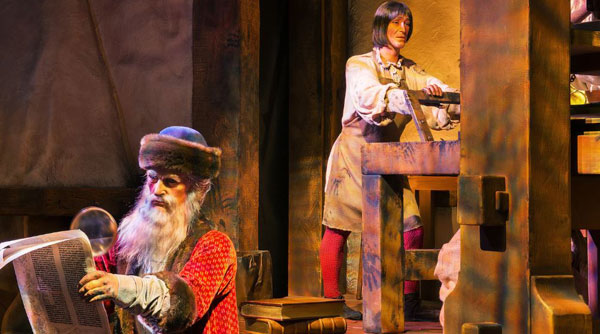
Timeless Works of Beauty and Majesty
The increased pace matches the excitement of The Renaissance and explosion of art. We pass by musicians, a man reading a book to an audience, plus artists working on a painting and sculpting a statue. These brief moments offer a clear idea on the variety of art that arose. Perrin’s statement about “worlds of poetry and philosophy, science, and music” does a good job summarizing the discoveries. Irons notes the “timeless works of beauty and majesty” as we glide through this era.
Jim Korkis offers clarifications on these scenes in this Mouse Planet article. First of all, the statue being worked on is meant to represent the era, not a specific piece. Disney also worked with experts in “Renaissance musicology” to ensure the music was accurate. Korkis clarifies that the man is playing a lute, while the woman plays a lira da braccio (bowed string instrument).
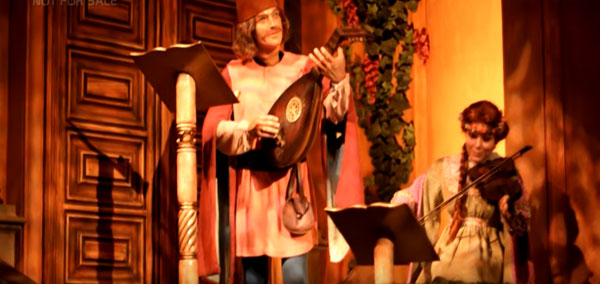
In the current version, we start with music that feels right for the era as we pass the musicians. It’s easy to imagine they’re performing for us during the trip. The musical choice of “Hallelujah” for the next segment shifts the tone more towards an epic presentation. The 1994 version also had a beautiful score, but its driving melody wasn’t as prominent. Bruce Broughton composed the music for the 2007 attraction, and he explained on the podcast that he initially proposed a love poem. Disney reminded him that determined guests would quickly translate it, so the more typical “Hallelujah” was safer.
Art Director Neil Engel informed me of the 2007 changes like adding a drape for modesty on the female sculpture. They also relocated the sculptor’s hand behind it so you wouldn’t notice he wasn’t actually touching the sculpture. In a similar vein, the musicians (with faces of the Carousel of Progress’ father and daughter) now look more convincing due to new animation. Engel also described several other enhancements, including a more historically accurate bench, a seated scholar (moved from the math scene and with the face of Andrew Jackson), and a redesigned backdrop.
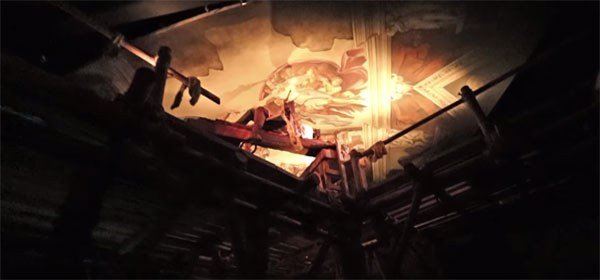
Behold the Sistine Ceiling
A signature moment in Spaceship Earth during every iteration is the shot of Michelangelo creating the Sistine ceiling. It’s an interesting view of the artist flat on his back with a small portion of the massive painting above him. I’ve always been a little disappointed by this scene because it’s given such emphasis by the narrators. In particular, the awe in which Cronkite says “behold, the majesty of the Sistine ceiling” promises more than the attraction can deliver. What’s most impressive is the way the designers nestle this scene in such a small surface area.
It’s interesting to note just how little Dench says about the Renaissance; the music takes over this scene as we pass the various examples. Perrin has a lot to say during this section, including this beautiful point: “As our minds soar, our hands find new expression in the flourishing world of art.” Cronkite also says more here, and the big change with later versions is the prominence of the music. The earlier versions used more narration instead to describe this part of our journey.
Engel also noted the 2007 move of the paintbrush to Michelangelo’s right hand. The change isn’t historically accurate, but it gives a better view of the artist’s face. They also painted the stained glass windows the proper colors from the real Sistine Chapel, and it looks more impressive than in past versions. Hearing about these small touches reinforces the attention to detail given to Spaceship Earth during the latest update.
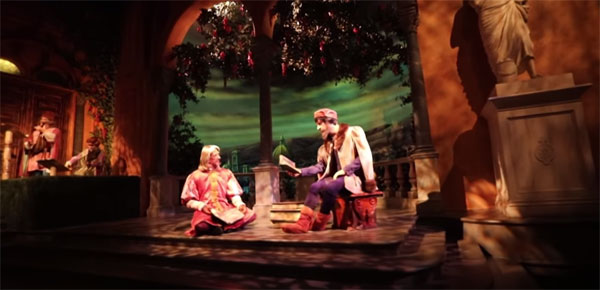
Guiding Us into a New Era
The Renaissance scenes offer a faster pace than earlier sections, but we’re just getting started. The artistic revolution improves our ability to communicate, and the next steps are technological achievements to make our world smaller. We’re inching towards the final act in our journey through Spaceship Earth, with the rise of mass media as a key culprit in that evolution. The renewed interest in art sets the stage for a more unified sense of purpose for humanity.
Next time, we venture into the Age of Invention and experience the steam powered printing press and the rise of electronic communications. The great big beautiful tomorrow is here!
Sources: INTERCOT, Martin’s Videos, Mouseplanet, All Ears, Secret Stories of Walt Disney World by Jim Korkis
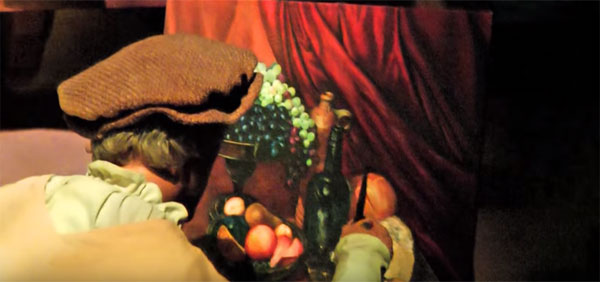



Leave a Reply